Overview
The players fight for supremacy over the 16 islands of the ORO archipelago.
There Are Two Ways to Play Kanaloa:
- The basic game – "Game of Islands" – gives a quick introduction to the game mechanics.
- The variant – “The Might of the Gods” – introduces the god tokens, with their special functions.
Contents
- 1 board, showing the 16 islands of the ORO archipelago

- 48 island cards (3 per island) e.g.

- 80 bridges in four colours (20 per colour)
In the online version, the number of bridges is unlimited




- 44 markers in 4 colours (11 per colour)
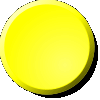
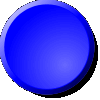
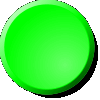
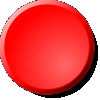
- 16 cardboard god tokens (used for the Might of the Gods variant)

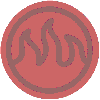


- 4 cardboard god boards (used for the Might of the Gods variant). In the online version, they are not
needed, as the god tokens are automatically counted.
- 1 set of rules
The ORO Archipelago
Consists of 16 islands of various sizes and names. The islands are connected by
marked links. During the course of the game the players may place their bridges
on these links. The sizes of the islands can be determined by the number of connections
they have;
- 4 small islands, each with 3 connections (eg DALI, KULU, etc)
- 11 large islands, each with 5 connections (eg ALOA, ELOI, etc)
- the main island ORO, with 7 connections
The
scoring track runs around the board, showing the number of victory points.
In the online version, the scoring is integrated in the game.
Goal of the Game
The goal is to win as many victory points as possible, through the control of the islands of the archipelago.
Basic Principles
The players fight for supremacy over the 16 islands, using bridges. The cards played decide where the bridges may be built. Whoever has the majority of the bridges on
an island, takes control of that island, and removes the bridges of his opponents.
This may affect the majorities on neighbouring islands as well.
Overview of a Turn
The player on turn, plays as many cards as he wants, and places the corresponding
bridges on the board.
If by this action he wins control over an island, he removes the bridges of his
opponent(s).
At the end of his turn, he draws one new card.
|
Preparation for the Game
Shuffle the island cards. Each player gets 4 cards and keeps them hidden from the
other players. The remaining cards are placed face down in a draw pile besides the
board. The players now choose one of their cards they don't want to keep. Once all players have chosen a card,
they place them face-up besides the draw pile.
NB: If fewer than 4 players are playing, draw extra cards from the draw pile until there are 4 face-up cards.
In future turns, the players may draw cards from either these face-up cards or from the face-down deck.
The god tokens and cards are only needed for the variant “Might of the Gods”.
Game of Islands
The Island Cards
1. Number of Cards in Hand
Each player starts the game with 3 cards in his hand.
The maximum number of cards he may have in his hand throughout the entire game is 5.
2. Playing Cards
A player on turn may play as many cards as he wants.
He may play all or none of his cards. Played cards are placed face-up on a discard pile. If a player has 5
cards in his hand at the start of his turn, he MUST play at least one card.
A player who cannot or does not want to play any cards, may discard one card from his hand, placing it under the discard pile, without showing it to the others.
(In the online version, the openly played cards are counted and displayed - cards discarded in secret are displayed as "???".)
3. Draw a new Card
At the end of his turn, the player must draw exactly one new card. This is mandatory.
The player may choose to take one of the face-up cards, or the uppermost
face-down card from the draw pile. If he chooses one of the face-up cards, he replaces it with
the top card from the draw pile, so that the following player has again
4 face-up cards to choose from.
Effects of the Cards
1. Building a Bridge
Nothing could be simpler! Whoever plays an Island card, places one bridge on one
of the free connections to the island named on the card.
It is possible to place several bridges during the same turn if several Island cards
are played – one bridge per card.
Example:
It is Betty’s (red) turn, and she has 4 cards in her hand. She plays the card ALOA (1),
and places a bridge on the connection ALOA-BAFI (2). Then she plays the card DALI (3),
and places a bridge on the connection ALOA-DALI (4).
She ends her turn by drawing the card RASI (5) from the 4 face-up cards.
Finally, she places the top card from the draw pile in the empty space (6).
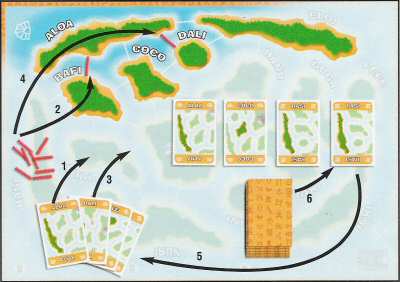
2. Swapping With an Opponent’s Bridge
In order to replace an opponent’s bridge with one of your own, you must play two suitable cards.
There are always 3 possible combinations of suitable cards that can achieve this.
Example: Mateo (green) wants to swap the bridge
between ALOA and BAFI. He can play the following combinations:
- 2 ALOA cards, or
- 2 BAFI cards, or
- 1 ALOA card and 1 BAFI card
Then he may build a bridge of his colour between ALOA and BAFI. The swapped bridge goes back to the opponent’s stock.
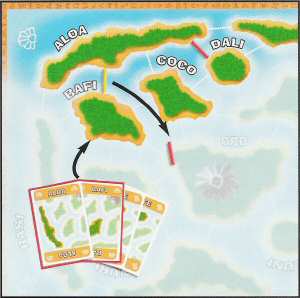
Control of the Islands
1. Majority of Bridges
1.a. Absolute Majority
As soon as a player occupies more than half of the available bridges,
he immediately gains control over the island. To indicate this, he places a marker
of his colour on this island.
Example: Betty plays an ELOI card.
She places one of her bridges on the connection ELOI-DALI (1).
She now has the majority of the bridges to DALI, and therefore takes control of it.
To show this, she places one of her markers on the island DALI (2).
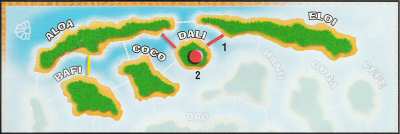
Once a player takes control over an island, all opponents' bridges to this island must be removed and returned
to their stock. The removal of bridges may also
affect the majority on neighbouring islands. If it does, affected players must remove their markers.
Example: Mateo plays an ALOA card, and places a bridge on the
connection ALOA-COCO (1). He then plays an ELOI card, and places a bridge on the connection ELOI-ALOA (2). He thus takes control of ALOA (3 of 5 connections), places his marker on ALOA (3), and removes Betty’s red bridges between ALOA and DALI (4).
Betty now no longer has the majority of bridges on DALI, and must therefore remove
her marker (5).
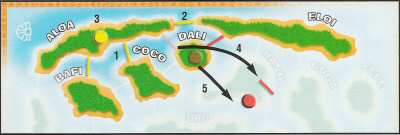
NOTE: The removal of bridges only applies when the majority on an island
changes. In later turns, the players may once again place bridges there, once they play the appropriate cards.
1.b. Relative Majority
If, by building the last free bridge, a player achieves a relative majority (i.e. he has the most
bridges to this island, but not enough for an absolute majority), he removes one bridge belonging to an opponent of his choice. He does not gain control
over the island, and does not place one of his markers.
Example All 4 players have one bridge to BAFI. On his turn, Mateo (green) plays a RASI card and places a bridge on the connection RASI-BAFI (1). With this move, he builds the last free bridge to BAFI, and has now more bridges than his opponents. He removes one bridge of his choice, in this case the red bridge belonging to Betty (2). Only if he can place one more
bridge on the BAFI-ORO connection will he gain control over BAFI via an absolute
majority. Only then may he remove all opponents' bridges from this island.
Possibilities:
- Large Island (2-1-1-1): The active player builds a second bridge
of his colour, while his opponents have only one. He removes one opponent's bridge of his choice.
- Main Island ORO (3-2-2 or 3-2-1-1): The active player builds a third bridge of his colour, while his opponents have only one or two. He removes
one opponent's bridge of his choice.
If a player by building the last bridge ties a relative majority with another player, he must remove a bridge from a player with only a single bridge.
Possibilities:
- Large Island: 2-2-1
- Main Island ORO: 3-3-1 or 2-2-2-1
In the case of a relative majority, one bridge is only removed if the active player fills(*) the last free bridge space in this turn.
It is not permitted to overlook the removal of the bridge.
(*)swapping an opponent's bridge is also considered as "filling".
NOTE: The removal of a bridge is not always to the active player’s advantage. If he cannot occupy the newly created free space, an opponent may have an opportunity to fill the gap and destroy his bridges.
After the removal of a bridge, the player may continue his turn. If he plays the appropriate card, he may fill the empty space, and convert his relative majority into an absolute majority. In this case, he places a marker of his colour
on the island, and removes all the opponents' bridges.
End of a Round
Once all the cards of the draw deck have been used, play continues until all the face-up cards
have been taken as well. When the last card is taken, the first round ends immediately,
and the first scoring takes place (see below).
After the first scoring, the discard pile is shuffled, and reformed as a draw pile.
From this new draw pile 4 cards are placed face-up.
NOTE: All bridges and markers remain on the board. The players retain the cards in their hands.
The next player continues his turn as normal.
Once all face-up and cards and the cards in the draw pile have been used for the second time, each player has one more turn.
In this final round, a player may pass, provided there is at least one player with more points who has yet to take his last turn. The player does not lose his turn,
he only takes it later.
Example: The following situation exists at the start of the last round:
- Betty has 12 points
- Adam has 10 points
- Mateo has 7 points
- Kayla has 6 points
The player order is Mateo, Betty, Adam, Kayla.
- Mateo decides to pass. He is allowed to do so as Betty and Adam have more points and have not yet taken their last turns.
- Betty must take her turn.
- Adam may no longer pass, as Betty has taken her last turn.
- Kayla decides to pass. She can do so as Mateo has more points, and has not yet taken his turn.
- Mateo must now take his turn.
- Kayla must now finally take her turn.
NOTE: Generally, there is an advantage of going last.
After a player has taken his turn in the final round, he discards all remaining cards in
his hand under the discard pile. Thus it is easy to see who has not yet taken his turn.
(In the online version, players keep their hand cards, because it
is obvious from the move-history, who has passed and who has completed his turn.)
After this final round is complete, final scoring takes place.
Scoring
Each player scores for the islands on which he has the absolute majority.
The value of an island is determined by the number of bridges not occupied by this player.
Each free space or space occupied by an opponent counts as one point.
Each controlled island (absolute majority) counts as one point as well.
The points are indicated by the markers on the scoring track. (In the online version,
the scores of all players are displayed besides the cards on hand.)
Example: Adam (yellow) controls
the island BAFI. Mateo occupies 1 bridge (green). The last connection is free.
Adam scores two points in the first scoring round (for the two connections he does not own),
and 3 points in the final scoring round (2 connections plus 1 point for the controlled island).
1. Points for both scorings
Note: The points for the final scoring are shown in brackets.
At scoring, a player gets the following points:
- 2 bridges on a small island: 1 point (2 points)
- 3 bridges on a small island: 0 points (1 points)
- 3 bridges on a big island: 2 point (3 points)
- 4 bridges on a big island: 1 point (2 points)
- 5 bridges on a big island: 0 point (1 points)
- 4 bridges on the main island ORO: 3 point (4 points)
- 5 bridges on the main island ORO: 2 point (3 points)
- 6 bridges on the main island ORO: 1 point (2 points)
- 7 bridges on the main island ORO: 0 point (1 points)
This shows that owning all bridges on an island does not give you the maximum points.
End of the Game
The game ends after the final scoring. The player with the most points wins.
If there is a tie, the player who took his turn earlier in the final round is the winner.
1. Premature End of the Game
If a player has already placed his 10 markers and he gains control of an 11th island,
he is immediately declared the winner.
Strategy Hints
In the first couple of rounds, do not play cards, simply draw new ones up to the
hand limit of 5. A larger hand of cards offers more choices.
Try to remove opponents’ bridges when playing cards. But beware of heavy losses in a duel.
The main island ORO yields the most points, but is difficult to defend. Especially at the beginning of the game it can be a mistake to gain control.
In the game “Might of the Gods” (see below), it is worthwhile to control islands early in the game to secure the god tokens.
Might of the Gods
These additional rules allow a richly varied game with new possibilities.
The God Tokens
At the beginning of the game, a god token is placed on each island (picture side up).
The player who first wins control over an island (absolute majority) takes the god token, and places it on the corresponding space on his god board. (In the online version, the god tokens are counted automatically. If you move the mouse
over the god token
icons, a quick-help explains the special functions.)
Thus each player can quickly determine which god tokens he and his opponents owns,
and the advantages they offer.
Each god token can be used exactly once, then it is removed from the game.
NOTE: All players can use the god tokens of each colour.

|
KANE immediately gives the player additional victory points. How many depends on the
island the god token is located:
- 1 point for a small island
- 2 points for a large island
- 3 points for the main island ORO
The victory points are recorded on the scoring track and the god token KANE is removed from the game.
|
KANALOA, KU, PELE, and LONO can only be used in the second round.
Effect of the God Tokens
The gods support the player in the following ways.

|
KANALOA functions as a joker. When it is played, a bridge may be placed at any free location. It is also possible to play KANALOA in combination with a suitable card to swap
an opponent’s bridge with one of your own.
|

|
KUwhoever plays KU may look at the cards of another player and steal one of them,
adding it to his own hand. This is particularly advantageous if one wants to snatch an important card from an opponent, or if one simply wants to see another player's
cards.
|

|
PELEwhoever plays PELE draws a random card from every other player and adds it to his hand. Then he chooses one card for each other player and gives it back to him. The advantage is that for a short time he has several cards to choose from, and it offers him the possibility to intrigue by giving the players the corresponding cards.
|

|
LONOallows an additional card to be drawn from either the draw pile or from the face-up
cards. This card can be played immediately, or held in hand for future use. When a face-up card is drawn, it is replaced immediately.
|
NOTE: By playing god tokens, it is possible that the hand size limit of 5 is
briefly exceeded. If this happens, the player must then play enough cards to reduce his hand
size to the maximum of 5 by the end of his turn.
When an island is won for the first time in the second round, the god token may be used immediately.
God tokens may not be used in the player's last turn before the final scoring.
Remarks concerning the Online Version
Visibility of Player Cards
Cards held in hand have a symbol in the upper left corner which indicates which players can see the card.
Every dot in this symbol represents an opponent - the colour of
the dot indicates the opponent who can see the card.
Cards which were discarded face-down are marked "???" to indicate that nobody knows what those cards are.
Show Moves of Opponents
To be able to understand the moves of an opponent, you can select the name of that
opponent or the lens icon in the "move history". Both reveal the game situation before his move.